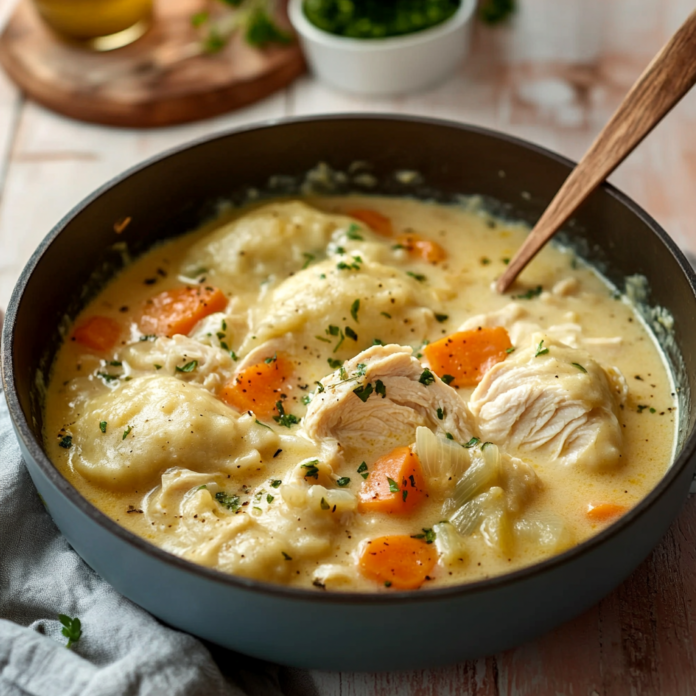Introduction and Quick Summary
Chicken and dumplings is a classic dish that brings warmth and comfort to any table. This beloved recipe combines tender chicken simmered in a rich, savory broth with fluffy dumplings that soak up all the delicious flavors. Whether you’re serving it on a chilly evening or for a special family gathering, this dish is sure to impress. In this article, we will walk you through everything you need to know about making the perfect chicken and dumplings.
Not only is this recipe simple to prepare, but it also makes excellent use of pantry staples and fresh ingredients that create a hearty meal. The delightful aroma of herbs mingling with the rich broth fills your kitchen as it cooks, making it hard to resist diving in as soon as it’s ready.
With step-by-step instructions and tips for serving and storing leftovers, you’ll have all the guidance needed to master this comforting dish. So grab your apron and let’s get started on creating a memorable meal that your family will ask for again and again!
Main Ingredients
Chicken
For this recipe, you will need 2 pounds of boneless, skinless chicken thighs or breasts. Thighs provide more flavor due to their higher fat content, but breasts can be used if preferred. Cut the chicken into bite-sized pieces before cooking to ensure even cooking throughout the dish. The meat should be tenderized by simmering in the broth for maximum flavor absorption.
Broth
You will need 6 cups of low-sodium chicken broth or stock. Using low-sodium broth allows you to control the saltiness of your dish better. The broth serves as the base of your chicken and dumplings, providing moisture and flavor while cooking the chicken. You can also use homemade broth if you have any on hand for an extra layer of taste.
Vegetables
Incorporate 1 cup each of diced carrots, celery, and onions into your recipe. These vegetables add depth to the flavor profile while providing essential nutrients. Sauté them until they are soft before adding your broth; this step enhances their natural sweetness and ensures they blend well into the overall dish.
Flour
To create your dumplings, you will need 2 cups of all-purpose flour along with baking powder and salt. The flour serves as the main ingredient for your dumpling dough, giving it structure while allowing it to remain light when cooked in the broth. Make sure to measure accurately for best results.
Milk
Using 1 cup of whole milk adds richness to your dumpling mixture. It helps create a soft texture while ensuring they are moist after cooking. Whole milk yields better results compared to lower-fat alternatives because of its higher fat content.
Herbs & Seasonings
A mix of seasonings including 1 teaspoon each of dried thyme, rosemary, salt, and pepper enhances the overall flavor of your dish. Fresh herbs may also be used if available; simply adjust quantities based on personal preference. The herbs complement both the chicken and dumplings beautifully.
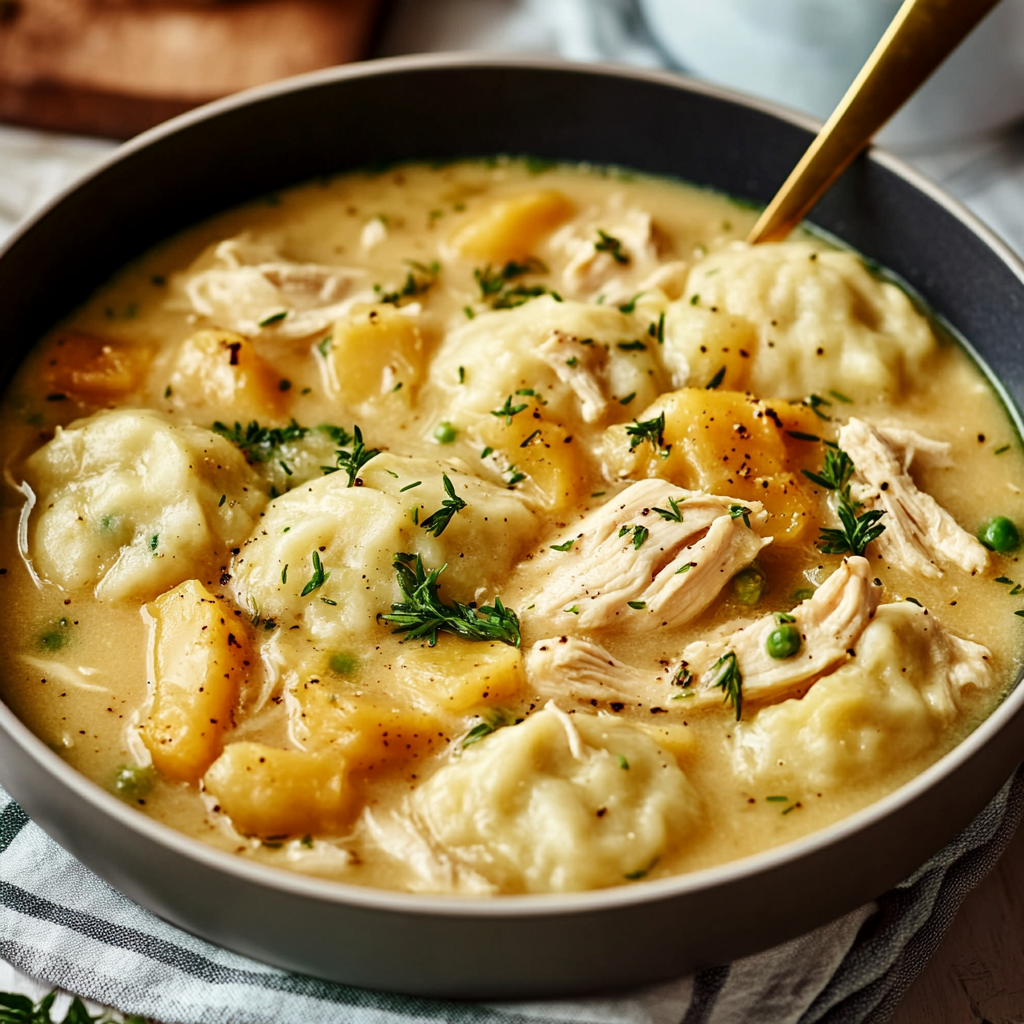
How to Prepare Chicken and Dumplings
Step 1: Prepare the Chicken
Start by heating a large pot over medium heat with a splash of olive oil. Once hot, add your diced chicken pieces alongside salt and pepper for seasoning. Cook until browned on all sides—about 5-7 minutes—before removing from heat temporarily. This initial browning step adds a robust flavor base that will carry throughout your dish.
Once browned, set aside the chicken on a plate while you prepare your vegetables in the same pot using residual oil and juices from cooking—the bits stuck at bottom known as fond are packed with flavor!
Step 2: Sauté Vegetables
Add diced carrots, celery, and onion into the pot where you cooked your chicken; sauté these vegetables over medium heat until they become translucent—around 4-5 minutes should do it! Stir occasionally so nothing sticks or burns.
As they cook down beautifully release their natural sweetness into those delightful fond bits left behind by chicken earlier! Once they reach desired tenderness sprinkle in dried herbs like thyme or rosemary before pouring in low-sodium chicken broth (6 cups). Bring mixture up towards boil—this will help meld flavors together nicely!
Step 3: Simmer & Thicken Broth
After reaching boiling point reduce heat back down into gentle simmer mode allowing flavors develop over next 15 minutes while stirring occasionally ensuring nothing clumps at bottom! Return previously cooked chicken pieces back into pot along with any juices that accumulated during resting period—it’s all about maximizing flavor here!
Allow soup mixture continue bubbling gently until fully cooked through around additional 10 minutes later! If desired thicker consistency achieved just mix equal parts cornstarch/water slurry adding gradually until reaches level preferred!
Step 4: Make Dumpling Dough
While soup simmers prepare easy homemade dumpling dough! In separate bowl combine flour (2 cups), baking powder (1 tablespoon), salt (½ teaspoon), then whisk together dry ingredients thoroughly before adding whole milk (1 cup). Start mixing gently until no dry spots remain—be careful not overmix otherwise texture turns tough!
Dumpling should feel slightly sticky yet manageable; if necessary adjust consistency using more flour/milk depending how wet/dry feel after combining ingredients successfully let rest few minutes before shaping them!
Step 5: Drop Dumplings Into Soup
Once soup has thickened slightly use spoonfuls drop prepared dumpling mixture right onto surface bubbling broth ensuring space between each so they can expand during cooking process—don’t overcrowd! Cover tightly lid allowing steam build-up which helps cook through evenly while soaking up delicious flavors from surrounding liquid below!
Cook undisturbed around additional 15 minutes; check periodically lifting lid releasing some steam clouds avoid losing too much moisture within pot itself!
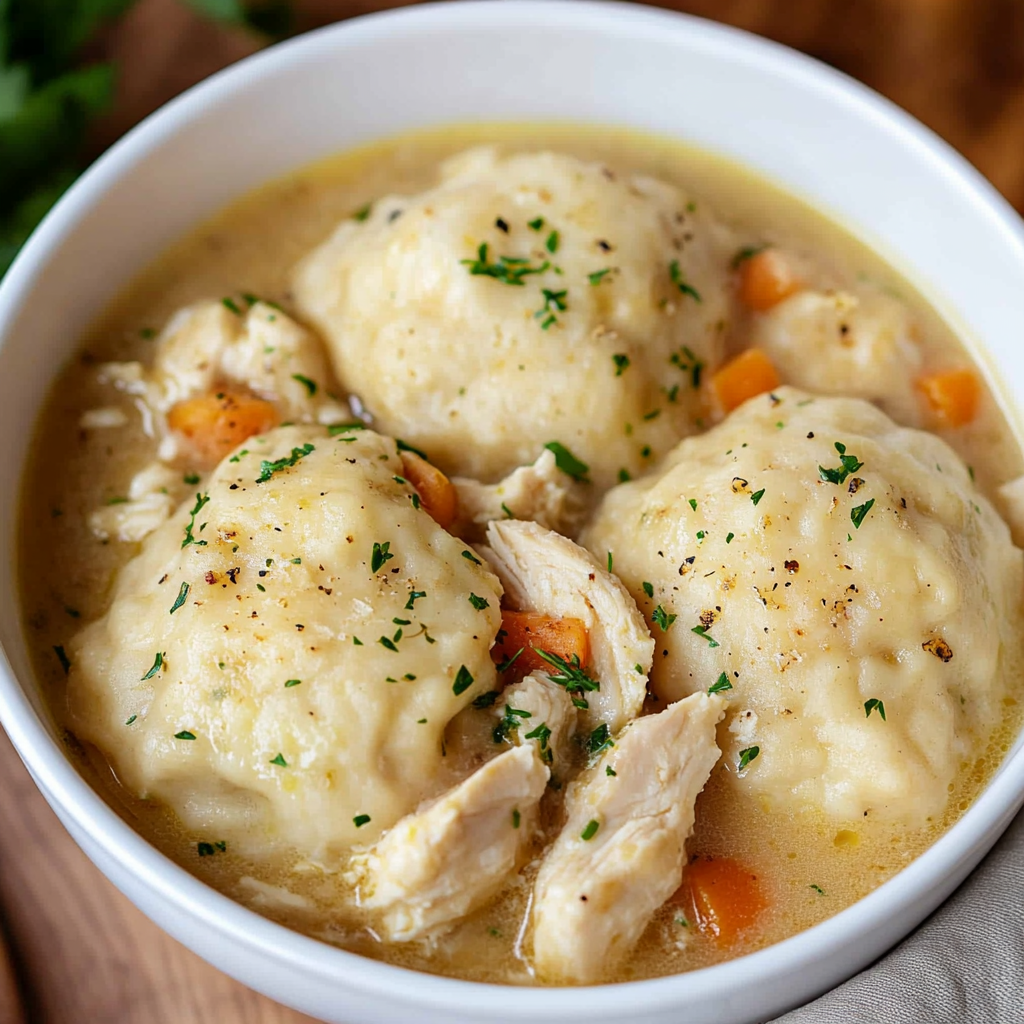
Serving and Storing Tips
Serving Suggestions
Serve hot bowls filled generously with warm comforting Chicken And Dumplings topped off fresh parsley sprinkled atop before digging in—this adds vibrant color contrast while enhancing presentation immensely! Pair leftovers alongside crusty bread slices perfect mopping up every last drop left behind.
For those looking for added zing consider drizzling lemon juice over each portion just prior eating elevating experience further—fresh citrus brightens flavors ultimately bringing balance overall richness found here!
Make sure everyone has plenty napkins handy because trust me—you won’t want miss single mouthful when digging into deliciousness served today!
Storage Guidelines
If there are any leftovers (which sometimes happens!), allow cooling completely prior transferring into airtight container—refrigerated they’ll keep well stored within next three days under proper conditions! To reheat simply place desired amount back onto stovetop low flame stirring occasionally until warmed through again—not microwaving recommended since could result mushy texture rather than original delightful fluffiness obtained freshly made upon first serving!
Do note though addition moisture might be required after refrigeration period given how absorbent dough tends become once settled down overnight—so feel free adding bit extra stock/water if necessary whilst reheating ensuring maintain ideal consistency throughout process itself!
Mistakes to avoid
One common mistake when making chicken and dumplings is not seasoning the broth adequately. The broth serves as the flavor foundation for the entire dish. If it lacks seasoning, the chicken and dumplings will also be bland. Use a mix of herbs, spices, and salt to enhance the broth’s flavor. Taste as you go, adjusting the seasonings until you achieve a well-rounded taste.
Another mistake is overcooking the dumplings. Dumplings should be fluffy and tender, but cooking them for too long can lead to a gummy texture. To avoid this, follow the recommended cooking time closely and check for doneness regularly. When they are cooked through but still firm, remove them from the heat.
Using low-quality chicken can also ruin your dish. Opt for fresh or high-quality frozen chicken for better flavor and texture. Avoid using pre-cooked or canned chicken, as these options can lead to a less satisfying outcome. The quality of your ingredients directly affects the final dish, so choose wisely.
Additionally, many people overlook the importance of letting the chicken rest before shredding it. Allowing it to rest for about 10 minutes helps retain juices and enhances its flavor. Skipping this step can result in dry chicken and an unappealing texture in your chicken and dumplings.
Finally, some cooks fail to balance their vegetable additions properly. While it’s tempting to add every vegetable on hand, stick to classics like carrots, celery, and onions for a traditional flavor profile. Too many different veggies can overwhelm the dish and distract from its core essence.
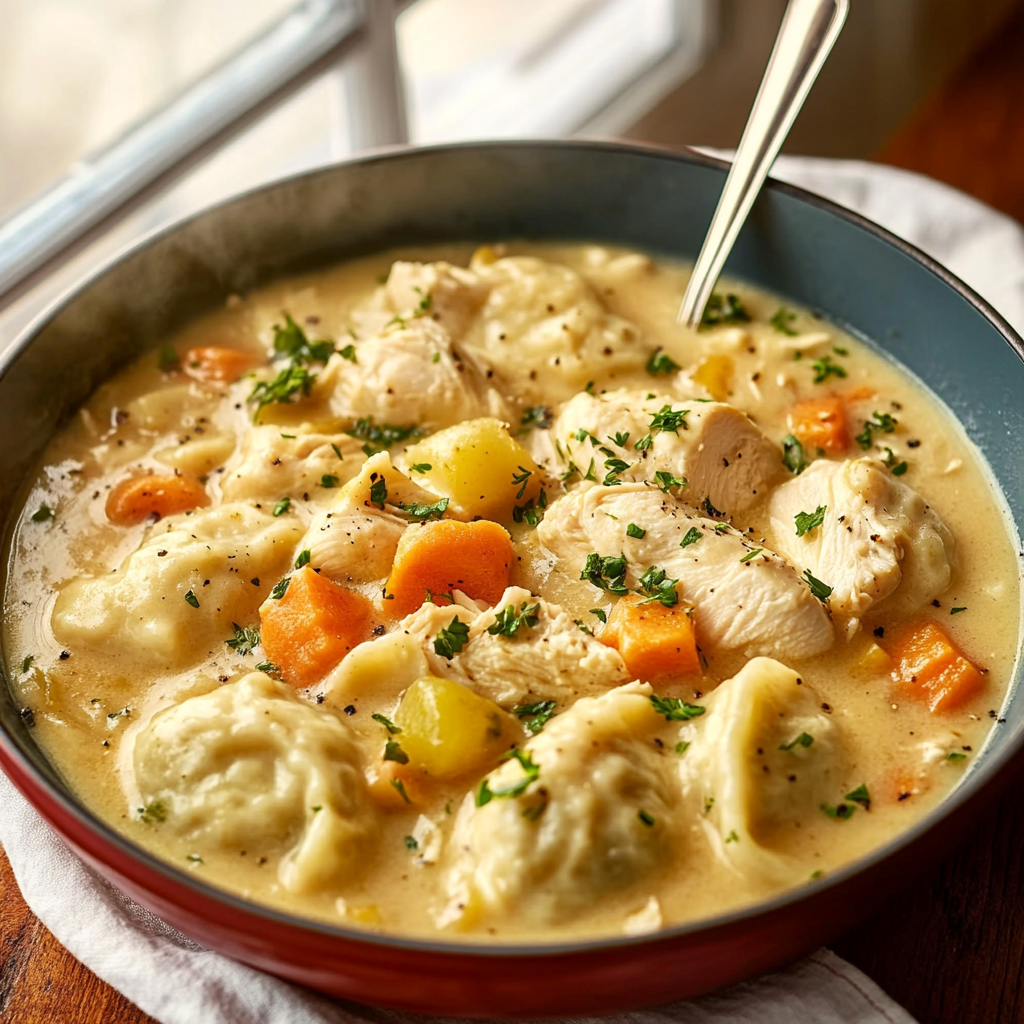
Tips and tricks
To elevate your chicken and dumplings, consider using homemade broth instead of store-bought options. Homemade broth is richer in flavor and allows you to control the seasoning better. Simmering bones with vegetables and herbs brings out deeper flavors that store-bought broth often lacks.
Experimenting with herbs can also enhance your dish significantly. Fresh parsley, thyme, or rosemary can infuse aromatic qualities into your chicken and dumplings that dried herbs cannot replicate. Adding these fresh ingredients towards the end of cooking ensures their flavors remain vibrant.
Another effective tip is to prepare your dumpling dough carefully. Over-mixing can lead to tough dumplings instead of light ones. Combine your ingredients gently until just mixed; this approach promotes tenderness in your dumplings.
Using buttermilk or yogurt in your dumpling recipe introduces a subtle tanginess that elevates their overall taste profile. The acidity enhances flavor while helping create a lighter texture than traditional milk or water.
Consider garnishing with fresh herbs before serving for an added pop of color and freshness. A sprinkle of chopped parsley or chives not only makes the dish visually appealing but also adds an extra layer of flavor that complements the richness of chicken and dumplings beautifully.
Suggestions for Chicken and Dumplings
When preparing chicken and dumplings, think about incorporating different types of protein if you’re looking for variety. For instance, adding sausage enhances depth while keeping it hearty without straying too far from tradition.
For those who prefer a creamier version, adding heavy cream or half-and-half at the end creates a luscious sauce that coats both chicken and dumplings beautifully. This addition works well alongside traditional broth-based recipes while providing a comforting twist.
If you’re looking for quicker preparation methods without sacrificing quality, consider using an Instant Pot or slow cooker for cooking your chicken beforehand. These appliances allow you to achieve tender results with minimal effort while freeing up time to focus on perfecting your dumpling recipe.
Don’t shy away from experimenting with spices either! A dash of cayenne pepper or smoked paprika adds warmth without overwhelming flavors—perfect for those who enjoy an extra kick in their comfort food dishes.
Lastly, remember that leftovers can be repurposed creatively! Transform any remaining soup into a casserole by topping it with biscuit dough before baking until golden brown—this gives new life to yesterday’s meal while maintaining its delicious flavors.
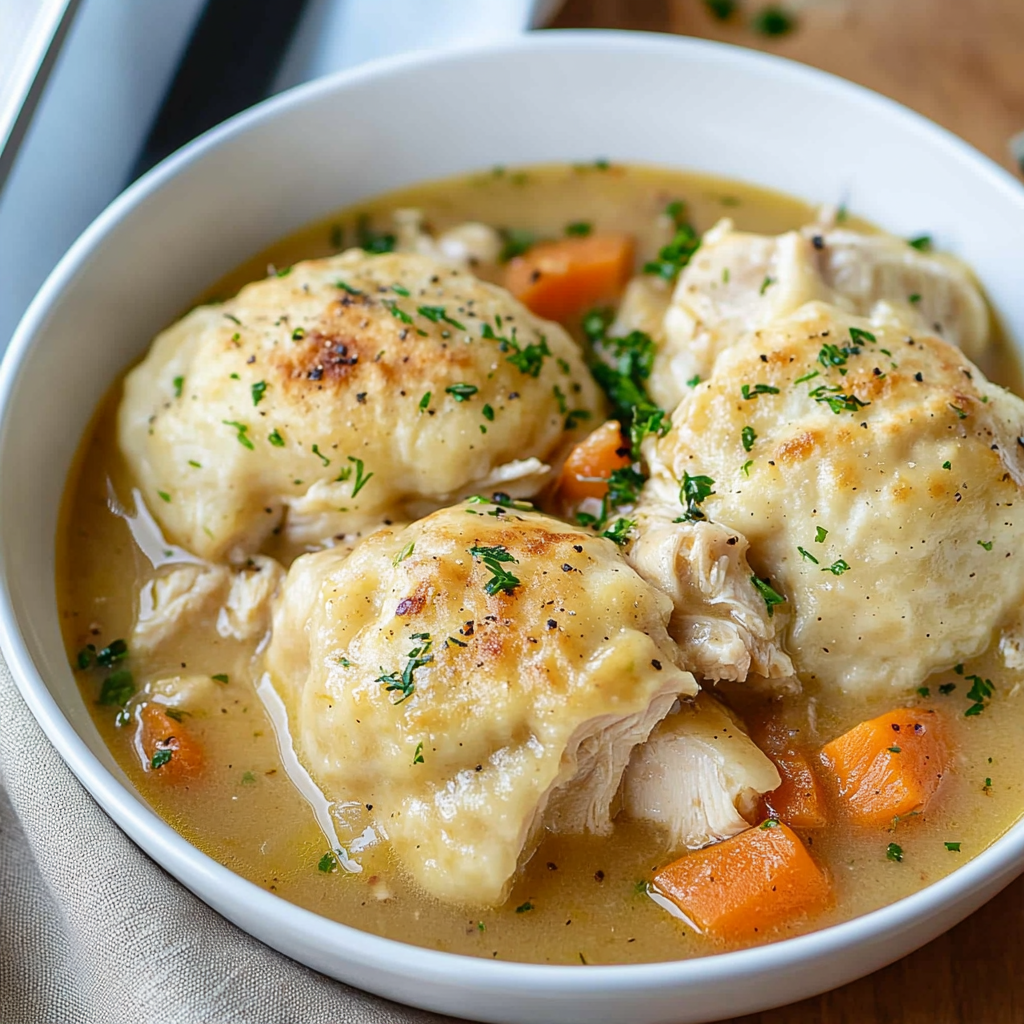
FAQs
What is the best type of chicken for Chicken and Dumplings?
The best type of chicken for chicken and dumplings is bone-in pieces like thighs or breasts because they provide robust flavor during cooking due to their fat content compared to skinless cuts—or even whole chickens! Bone-in meat adds richness as it simmers in broth while keeping meat moist throughout preparation; however, feel free to use boneless if preferred!
Can I use frozen vegetables instead of fresh?
Yes! You can definitely use frozen vegetables in place of fresh ones when making chicken and dumplings—but make sure they’re thawed first so they cook evenly along with everything else! Frozen varieties often retain nutrients well since they’re flash-frozen soon after harvest; just adjust cooking times slightly depending on what kind you choose!
How do I store leftover Chicken and Dumplings?
Store leftover chicken and dumplings in an airtight container within two hours after serving—refrigerate them promptly! They will last about three days stored this way; reheat gently over low heat on stovetop (adding broth if needed) until warmed through! For longer storage periods—consider freezing portions instead!
Can I make Chicken Dumpling Soup instead?
Absolutely! You could easily transform any recipe into more soupy versions simply by increasing liquid amounts substantially while cutting back on how much dough you incorporate at once—this allows space for soup-like consistency without compromising flavors!
What variations exist within Chicken Dumpling recipes?
Many variations exist across regions featuring distinct styles—from Southern-style fluffy biscuits served atop rich broths versus Asian-inspired steamed wontons filled with flavorful meats & veggies served alongside clear broths—each offering unique ways to enjoy this comforting classic!
Is it possible to make Chicken Dumplings gluten-free?
Yes! You may substitute regular flour used in traditional recipes with gluten-free blends made specifically designed for baking purposes—several brands offer all-purpose mixes containing rice flour/cornstarch/tapioca flour combinations yielding excellent results just like their counterparts!
Conclusion
In summary, mastering chicken and dumplings involves avoiding several critical mistakes while implementing valuable tips throughout preparation stages—from choosing high-quality ingredients down through careful attention paid towards cooking processes surrounding both proteins involved as well as accompanying dough mixtures used within this comforting classic dish! Keep these suggestions close at hand next time you’re readying yourself up against anyone craving delicious warm bowls filled full hearty goodness—it’ll surely impress everyone gathered around dinner tables! Ultimately remember: practice makes perfect so don’t hesitate diving right back into kitchen adventures experimenting further each time—you won’t regret taking chances here!
